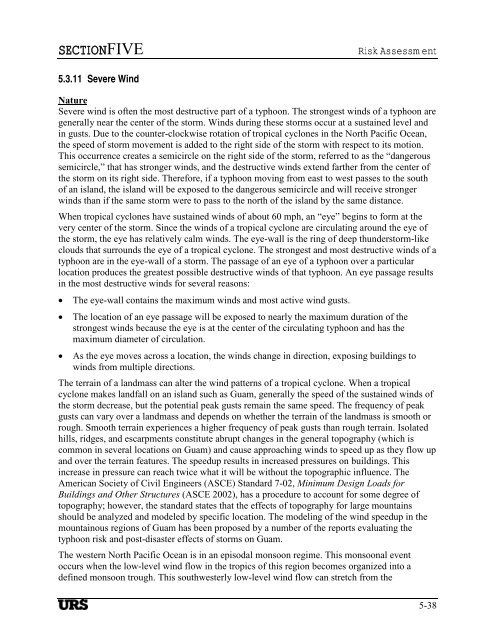Guam Hazard Mitigation Plan - Western States Seismic Policy Council
Guam Hazard Mitigation Plan - Western States Seismic Policy Council
Guam Hazard Mitigation Plan - Western States Seismic Policy Council
You also want an ePaper? Increase the reach of your titles
YUMPU automatically turns print PDFs into web optimized ePapers that Google loves.
SECTIONFIVERisk Assessment5.3.11 Severe WindNatureSevere wind is often the most destructive part of a typhoon. The strongest winds of a typhoon aregenerally near the center of the storm. Winds during these storms occur at a sustained level andin gusts. Due to the counter-clockwise rotation of tropical cyclones in the North Pacific Ocean,the speed of storm movement is added to the right side of the storm with respect to its motion.This occurrence creates a semicircle on the right side of the storm, referred to as the “dangeroussemicircle,” that has stronger winds, and the destructive winds extend farther from the center ofthe storm on its right side. Therefore, if a typhoon moving from east to west passes to the southof an island, the island will be exposed to the dangerous semicircle and will receive strongerwinds than if the same storm were to pass to the north of the island by the same distance.When tropical cyclones have sustained winds of about 60 mph, an “eye” begins to form at thevery center of the storm. Since the winds of a tropical cyclone are circulating around the eye ofthe storm, the eye has relatively calm winds. The eye-wall is the ring of deep thunderstorm-likeclouds that surrounds the eye of a tropical cyclone. The strongest and most destructive winds of atyphoon are in the eye-wall of a storm. The passage of an eye of a typhoon over a particularlocation produces the greatest possible destructive winds of that typhoon. An eye passage resultsin the most destructive winds for several reasons:• The eye-wall contains the maximum winds and most active wind gusts.• The location of an eye passage will be exposed to nearly the maximum duration of thestrongest winds because the eye is at the center of the circulating typhoon and has themaximum diameter of circulation.• As the eye moves across a location, the winds change in direction, exposing buildings towinds from multiple directions.The terrain of a landmass can alter the wind patterns of a tropical cyclone. When a tropicalcyclone makes landfall on an island such as <strong>Guam</strong>, generally the speed of the sustained winds ofthe storm decrease, but the potential peak gusts remain the same speed. The frequency of peakgusts can vary over a landmass and depends on whether the terrain of the landmass is smooth orrough. Smooth terrain experiences a higher frequency of peak gusts than rough terrain. Isolatedhills, ridges, and escarpments constitute abrupt changes in the general topography (which iscommon in several locations on <strong>Guam</strong>) and cause approaching winds to speed up as they flow upand over the terrain features. The speedup results in increased pressures on buildings. Thisincrease in pressure can reach twice what it will be without the topographic influence. TheAmerican Society of Civil Engineers (ASCE) Standard 7-02, Minimum Design Loads forBuildings and Other Structures (ASCE 2002), has a procedure to account for some degree oftopography; however, the standard states that the effects of topography for large mountainsshould be analyzed and modeled by specific location. The modeling of the wind speedup in themountainous regions of <strong>Guam</strong> has been proposed by a number of the reports evaluating thetyphoon risk and post-disaster effects of storms on <strong>Guam</strong>.The western North Pacific Ocean is in an episodal monsoon regime. This monsoonal eventoccurs when the low-level wind flow in the tropics of this region becomes organized into adefined monsoon trough. This southwesterly low-level wind flow can stretch from the5-38




